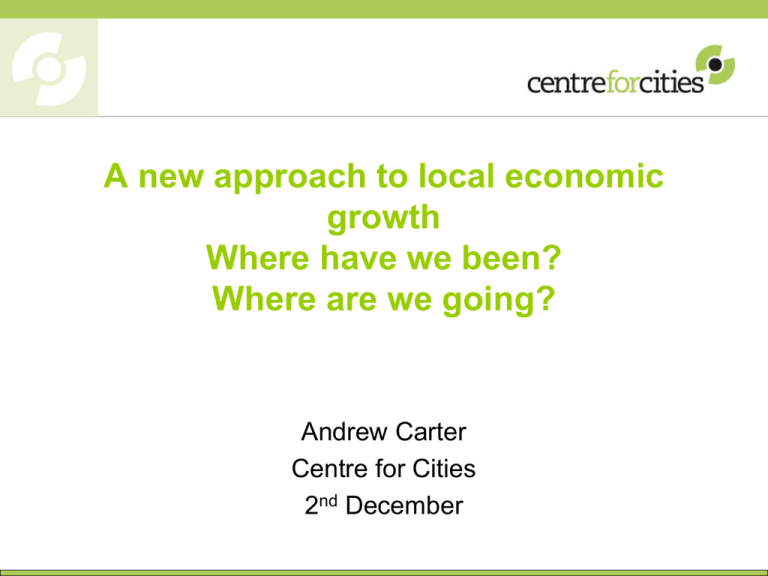Presentation by Andrew Carter
advertisement

A new approach to local economic growth Where have we been? Where are we going? Andrew Carter Centre for Cities 2nd December • The challenges facing UK cities over the next decade • Key lessons on the nature of private sector jobs growth • Why local enterprise partnerships are important and what they should do • Where next following the Local Growth White Paper? Need different sources of job growth over the next decade compared to the last Average net fall in manufacturing employment among English cities between 1998 and 2008 was 33%. That’s obviously not going to be the case over the next decade Office for Budget Responsibility estimates 600,000 or 490,000 or 330,000 jobs could go from the public sector by 2015/16. Public sector cuts will hit every city – but vulnerability varies … this makes private sector job creation ever more pressing London has been the top performer on private sector jobs growth in recent decades 38% of net additional private sector jobs between 1998 and 2008. . . . But not only the South Top 10 performers on private sector jobs growth in North & Midlands Most Core Cities have been doing fairly well in terms of total jobs added and percentage growth. Bottom 10 performers on private sector jobs growth in North & Midlands Places like Stoke and Burnley still struggling with industrial decline. Birmingham and Nottingham the exceptions among Core Cities – though there’s a question mark about the Nottingham data. Variable performance on unemployment Populations normally respond to changing economic opportunities Manufacturing is unlikely to be a major source of jobs growth Niche sectors are important but not the only answer Need to pay more attention to all firms LEPs – the latest institutional approach • 24 local enterprise partnerships approved • Most major cities covered • London partnerships could follow Natural economic areas are important The strength of Manchester as an economic centre generates labour market relationships with neighbouring areas: Overall Commuting Patterns (ward level) Affects housing and business choices in the city region Variable Size, Scale and Complexity “Who pays should benefit, who benefits should pay” Some LEPs are better positioned for growth than others High skills means high wages High wages in the private sector except Oxford What should LEPs focus on? RGF is not the main event . . . What should LEPs focus on? Local Growth – what did the White Paper tell us? • Not “everywhere will, or will want to, become an economic powerhouse” • There will be no additional funding for partnerships • Business rates could be localised as a growth incentive • No real role for partnerships in skills policy • Confirmed the creation of new ‘Growth Hubs’ And what didn’t it resolve? 1. 2. 3. 4. So will local enterprise partnerships work? • Rebalancing the economy geographically will not be an easy task - growth will continue to be uneven • Success not clearly defined – so can they ‘not work’? • Local enterprise partnerships should focus on improving the business environment – getting the basics right • Central government should re-examine funding and powers A new approach to local economic growth Where have we been? Where are we going? Andrew Carter Centre for Cities a.carter@centreforcities.org 020 7803 4300











